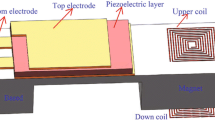Abstract
This paper investigates and compares the efficiencies of four different interfaces for vibration-based energy harvesting systems. Among those four circuits, two circuits adopt the synchronous switching technique, in which the circuit is switched synchronously with the vibration. In this study, a simple source-less trigger circuit used to control the synchronized switch is proposed and two interface circuits of energy harvesting systems are designed based on the trigger circuit. To validate the effectiveness of the proposed circuits, an experimental system was established and the power harvested by those circuits from a vibration beam was measured. Experimental results show that the two new circuits can increase the harvested power by factors 2.6 and 7, respectively, without consuming extra power in the circuits.
Similar content being viewed by others
References
Chandrakasan A, Amirtharajah R, Cho S H. Design considerations for distributed microsensor systems. In: Proceedings of the 21st IEEE Annual Custom Integrated Circuits Conference, May16–19, San Diego, 1999: 279–286
Davis C, Lssieuter G. An actively tuned solid-state vibration absorber using capacitive shunting of piezoelectric stiffness. Journal of Sound Vibration, 2000, 232: 601–617
Rabaey J M, Ammer M J, Julio L. da Silva. PicoRadio supports ad hoc ultra-low power wireless networking. Computer, 2000, 33: 42–48
Ottman G K, Bhattt A C, Hofmann H. Adaptive piezoelectric energy harvesting circuit for wireless, remote power supply. IEEE Transactions on Power Electronics, 2002, 17(5): 669–676
Hofmann H, Ottman G K, Lesieutre G A. Optimized piezoelectric energy circuit using step-down converter in discontinuous conduction mode. IEEE Transactions on Power Electronics, 2002, 18(2): 696–703
Lesieutre G A, Hofmann H, Ottman G K. Damping as a result of piezoelectric energy harvesting. Journal of Sound and Vibration, 2004, 269: 991–1001
Guyomar D, Badel A, Lefeuvre E. Toward energy harvesting using active materials and conversion improvement by nonlinear processing. IEEE Transactions on Ultrasonics, Ferroelectrics, and Frequency Control, 2005, 52(4): 584–595
Badel A, Benayad A, Lefeuvre E. Single Crystals and nonlinear process for outstanding vibration-powered electrical generators. IEEE Transactions on Ultrasonics, Ferroelectrics, and Frequency Control, 2006, 53(4): 673–684
Lefeuvre E, Adrien B, Claude R. A comparison between several vibration-powered piezoelectric generators for standalone systems. Sensors and Actuators A, 2006, 126: 405–4
Yabu T, Onoda J. Non-power-supply semi-active vibration suppression with piezoelectric actuator. In: Proceedings of the 47th Symposium on Structural Strength, Japan Society of Astronautics, Kanazawa, Japan, July 20–22, 2005: 48–50
Author information
Authors and Affiliations
Corresponding author
Rights and permissions
About this article
Cite this article
Qiu, J., Jiang, H., Ji, H. et al. Comparison between four piezoelectric energy harvesting circuits. Front. Mech. Eng. China 4, 153–159 (2009). https://doi.org/10.1007/s11465-009-0031-z
Received:
Accepted:
Published:
Issue Date:
DOI: https://doi.org/10.1007/s11465-009-0031-z




